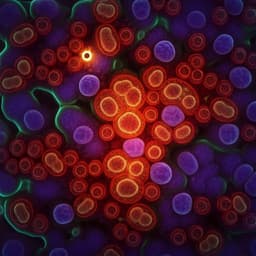
Biology
DaXi—high-resolution, large imaging volume and multi-view single-objective light-sheet microscopy
B. Yang, M. Lange, et al.
Discover DaXi, a groundbreaking light-sheet microscope that combines the ease of traditional microscopy with advanced imaging capabilities. Developed by a team of researchers including Bin Yang and others, DaXi offers high-resolution imaging and fast volumetric capture, ideal for studying complex biological systems. Experience the future of microscopy with unparalleled detail and efficiency.
~3 min • Beginner • English
Introduction
The study addresses limitations of single-objective light-sheet microscopy (oblique plane microscopy, OPM) for imaging large living specimens. Prior OPM approaches offering full numerical aperture (NA) detection were constrained to high magnifications (×60–×100) and small fields of view (~200 µm), limiting throughput and precluding whole-embryo imaging without tiling. Large samples also degrade image quality through absorption, refraction and scattering, typically requiring complex multi-objective setups or sample rotation for multi-view imaging. The authors propose DaXi, a single-objective, oblique-plane light-sheet system that overcomes these constraints by combining a custom remote focusing objective for wide FOV and high resolution, a light-sheet stabilized stage scanning (LS3) method for large-range, blur-free volumetric imaging, dual-view illumination/detection for improved coverage, and a remote coverslip configuration to enable inverted operation and high-throughput mounting.
Literature Review
- Full-NA OPM via refractive index–mismatched remote focusing has been shown previously but only at high magnifications with limited FOV (~200–220 µm), restricting applications to large specimens.
- Standard remedies such as tiling sacrifice speed and can introduce stitching artifacts, and galvo-only scanning degrades image quality off-axis.
- Multi-view light-sheet microscopes improve coverage and contrast but often require complex multi-objective geometries or sample rotation, reducing speed and complicating mounting.
- SCAPE2.0 and SoPi, using the same primary objective as DaXi, report effective detection NA ~0.35 with similar FOV but lower resolution and sensitivity than full-NA OPM.
- Alternative dual-view OPM implementations (for example, translating tilted mirrors with a beam splitter) incur light loss and slower switching.
This body of work motivates a single-objective design that delivers wide FOV, near-full detection NA, fast volumetric rates over large ranges without tiling, and efficient dual-view imaging without complex sample manipulation.
Methodology
Microscope design and optics:
- Single-objective OPM using a primary objective (O1: Olympus XLUMPLFLN 20XW NA 1.0, water) for oblique light-sheet excitation and fluorescence collection. Fluorescence is relayed via aberration-free remote focusing to a secondary objective (O2: Olympus UPLXAPO20X) and imaged by a custom tertiary objective (O3: AMS-AGY v2.0) oriented at 45°.
- Custom tertiary objective: NA 1.0, up to 750 µm FOV, glass-tipped with zero working distance for hemispherical collection in air, enabling near-full detection NA (~0.97) and large FOV at low magnification (×20).
- Optical train uses tube lenses (TL1–TL6) to conjugate O1 and O2 pupils; intermediate image formed at O2 with 1:33 magnification (ratio of refractive indices), minimizing aberrations. Emission filtered by single-band or quad-band filters and detected with sCMOS (Hamamatsu ORCA-Flash 4.0). Effective pixel sizes at sample: 146 nm (PSF calibration), 265 or 440 nm (imaging). O3 mounted on piezo for fine focus.
Light-sheet stabilized stage scanning (LS3):
- During each camera exposure, the sample stage moves continuously along x (scanning axis) while a galvo applies a compensatory motion to the light-sheet and detection planes to cancel relative motion, eliminating motion blur. The galvo resets during camera readout before the next frame. This preserves image quality across long ranges (limited only by stage travel; 75 mm here) while maintaining high temporal resolution.
- Provides the speed of galvo scanning and the extensive range and optical fidelity of stage scanning without tiling. Limiting factors are camera speed and fluorophore brightness.
Dual light-sheet illumination and view flipping:
- Two switching galvos route illumination/detection through one of two mirror paths, effectively flipping the image and alternating the light-sheet incident angle between ±45° while keeping the intermediate image on O3’s front surface. Both views share upstream and downstream optics, maximizing efficiency and simplifying alignment.
- Orthogonal views provide complementary penetration paths through scattering/absorbing structures; post hoc registration and fusion yield more complete, higher-contrast volumes.
Remote coverslip for inverted configuration:
- The coverslip required by O2 can be repositioned to support the sample at O1’s focal space, converting from upright (dipping) to inverted (immersion) without degrading performance. Simulations attribute the main aberration to primary spherical, which can be compensated by relay tube lens adjustments; bead PSF measurements confirm similar performance in both configurations.
Illumination control and stripe reduction:
- A two-axis galvo conjugated to the sample plane sets the light-sheet incident angle (nominally 45°; effective excitation NA ~0.08). During each frame, the sheet is swept from −6° to +6° in-plane to reduce striping artifacts from absorption/obstruction.
Scanning and control hardware/software:
- Galvo (Cambridge Tech 20 mm) conjugated to O1/O2 pupils for scanning/descanning. Motorized stage (ASI MS-2000) for positioning and volumetric scanning. Automated water immersion dispenser and environmental chamber (~28 °C) for long-term live imaging.
- Acquisition via Micro-Manager 2.0 Gamma with custom scripting; device timing controlled by NI DAQ (cDAQ-9178, NI 9263 AO, NI 9401 DIO) using Python NI-DAQmx API; Pycro-Manager alternative supported.
Image processing pipeline (dexp):
- TIFF hyperstacks converted to zarr (lossless compression, 5–10×). Processing on GPU server (200 TB storage; 4× NVIDIA V100 32 GB).
- Per view: deskew to sample (xyz) coordinates; dehaze to remove background; multiscale iterative registration (chunked, translation model, spline-interpolated vector field; 4 iterations; minimal chunk 32×32×32) of view 2 to view 1; content-aware fusion using Sobel gradient–based blend maps; illumination intensity correction along y. Temporal stabilization across time points via L1-regularized inversion of relative phase-correlation shifts to recover absolute positions.
- Processing speed: ~1 min per time point per GPU; ~4 h for an 8 h dataset (~1,000 time points) using 4 GPUs. Single time point raw data ~8 GB (two views, ~1000×1024×2048×2 voxels).
PSF measurement and characterization:
- 100-nm fluorescent beads embedded in 0.5% agarose on #1.5 coverslips; images deskewed to xyz. PSFs rotated so long axis (z″) aligns with z; 1D Gaussian fits along x″, y, z″; FWHMs averaged over beads. Performance consistent across imaging volume, wavelengths, and magnifications; slight widening at FOV edges.
Segmentation and tracking (for developmental datasets):
- 3D cell boundary prediction with a neural network; hierarchical watershed (Higra) segmentation; tracking by network flow integer programming maximizing IoU between adjacent time points; track smoothing with Savitzky–Golay filtering; visualization by flow orientation.
Sample preparation:
- Zebrafish: dechorionated, embedded in 0.1% low-melting agarose (developmental imaging) or 2% agarose (calcium imaging), anesthetized with tricaine; maintained at 28 °C with gentle perfusion. Embryo orientations adapted to imaging goals.
- Drosophila egg chambers: dissected and cultured; transferred to glass-bottom dishes; mounted in imaging medium (Schneider’s with insulin, FBS, pen-strep).
Key Findings
- Resolution and PSF: Measured FWHM (mean±s.d., n=156 beads) along principal axes: x″ 479.9±28.0 nm, y 379.2±20.9 nm, z″ 1,864.9±174.3 nm. Achieved ~450 nm lateral and ~2 µm axial resolution with near-full detection NA.
- Imaging volume and FOV: Single-stack volumes up to 3,000×800×300 µm obtained without tiling. Camera-plane FOV 800 µm (y) × 420 µm (x′), corresponding to 800 µm (y) × 300 µm (z) in sample coordinates.
- Scanning range and speed: LS3 enables blur-free scanning over ranges limited by stage travel (75 mm), compared with ~300 µm for galvo-only. Typical speed ~10–30 s per volume for 2,000×800×300 µm; galvo scanning preferred for smaller volumes due to minimal settling.
- High-speed functional imaging: Whole-brain zebrafish calcium imaging at 3.3 Hz volumetric rate (0.3 s per 500×300×200 µm volume; 8 µm steps; 8 ms exposure).
- Long-term developmental imaging: Zebrafish tail development imaged for 8 h at 30–40 s per fused volume; per time point fused volume 4,000×2,000×360 voxels; complementary dual views improved coverage and contrast across regions.
- Throughput and multi-sample imaging: Sequentially imaged nine embryos embedded in 0.1% agarose over 8 h (~4.5 min per round), with normal development and single-cell resolution of somitogenesis. Remote coverslip enables inverted operation compatible with multi-well/microfluidics.
- Comparative performance: Versus prior full-NA OPM (~220 µm FOV at high magnification), DaXi offers ~18× larger FOV at slightly reduced resolution. Compared to SCAPE2.0/SoPi (effective NA ~0.35), DaXi achieves near-full NA (~0.97) with similar FOV and at least 2.6× higher optical throughput (modified etendue).
- Dual-view module: Fast, efficient switching without beam splitter losses, providing complementary views that fuse to higher-quality volumes; benefits observed in large, scattering specimens.
Discussion
DaXi addresses key limitations of single-objective light-sheet imaging in large, living specimens by combining wide field of view, near-full detection NA, and high-speed volumetric acquisition over long ranges without tiling. The custom tertiary objective preserves resolution at low magnification, while LS3 overcomes the scan-range and motion-blur trade-offs inherent in galvo- or stage-only strategies. Dual-view illumination/detection adds coverage and contrast in heterogeneous, scattering tissues and integrates efficiently in a single-objective geometry. The remote coverslip method unlocks inverted configurations compatible with standard mounting (multi-well plates, microfluidics), enhancing usability and throughput. Compared with alternative OPM designs that trade NA or FOV, or dual-view schemes that incur light loss and slower switching, DaXi demonstrates superior optical throughput and practical versatility. The system’s performance enables long-term, high spatio-temporal resolution imaging of development and neural activity without complex sample rotation or multi-objective setups, thereby directly serving the biological questions that require continuous, large-volume, single-cell–level observation.
Conclusion
The work introduces DaXi, a single-objective light-sheet microscope delivering high resolution (~450 nm lateral, ~2 µm axial), large single-stack volumes (up to 3,000×800×300 µm), and fast, long-range volumetric imaging via LS3, complemented by efficient dual-view illumination/detection and a remote coverslip approach for inverted operation. These advances collectively improve coverage, reduce artifacts, and increase throughput while maintaining compatibility with standard biological mounting workflows. Demonstrations include whole-embryo developmental imaging, whole-brain functional imaging, and sequential imaging of nine embryos.
Future directions include integrating adaptive optics to correct system/sample-induced aberrations, multi-view deconvolution to further enhance resolution, axially swept/thinner light sheets to boost axial resolution (with duty-cycle considerations), expanding to additional view angles, and applying smart microscopy and machine learning to improve imaging adaptivity and data processing. The methods may generalize to other OPM variants and light-sheet modalities and are well-suited for organoids and cleared tissues.
Limitations
- Residual system aberrations, largely from the primary objective, tilt and broaden the PSF; adaptive optics could improve correction.
- Galvo-only scanning degrades beyond ~300 µm; LS3 mitigates motion blur and range limits but overall speed remains bounded by camera performance and fluorophore brightness.
- Axial resolution could be improved with thinner or axially swept light sheets, but this reduces excitation duty cycle and may limit long-term live imaging suitability.
- Fusion currently relies on content-aware blending; multi-view deconvolution could further enhance resolution at added computational cost.
- Long-term imaging stability can be affected by occasional spontaneous embryo movements; effective immobilization protocols are required.
- Dual-view implementation is limited to two opposing orientations (±45°); additional angles could offer further coverage at increased complexity.
Related Publications
Explore these studies to deepen your understanding of the subject.







